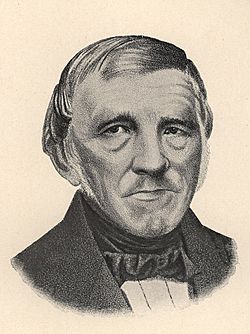Johann Franz Encke facts for kids
Quick facts for kids
Johann Franz Encke
|
|
|---|---|

Johann Franz Encke
|
|
| Born | 23 September 1791 |
| Died | 26 August 1865 (aged 73) |
| Nationality | German |
| Alma mater | University of Göttingen |
| Known for | 12P/Pons-Brooks comet |
| Awards | Cotta prize (1817) Royal Medal (1828) Gold Medal of the Royal Astronomical Society (1824, 1830) |
| Scientific career | |
| Fields | Astronomy |
| Institutions | University of Berlin |
| Academic advisors | Carl Friedrich Gauss |
| Doctoral students | Johann Gottfried Galle Leopold Kronecker Demetrios Kokkidis |
Johann Franz Encke (German pronunciation: YO-hahn Frahnts ENG-keh; September 23, 1791 – August 26, 1865) was a German astronomer. He was famous for calculating the paths of comets and asteroids. He also helped figure out the distance from Earth to the Sun. Encke made important observations of the planet Saturn.
Contents
Early Life and Learning
Johann Encke was born in Hamburg, Germany. His father was a pastor, and Johann was the youngest of eight children. When he was only four, his father passed away, and his family faced tough times. Luckily, a kind teacher helped him get a good education at the Gelehrtenschule des Johanneums.
From 1811, he studied mathematics and astronomy at the University of Göttingen. His teacher was the famous scientist Carl Friedrich Gauss. Encke also served in the military for a short time. He was a sergeant in the artillery during campaigns in 1813–1814. He returned to his studies, then served again until 1815, becoming a lieutenant.
Discovering Comets
In 1816, Encke became an assistant at the Gotha Observatory in Seeberg. There, he studied the Great comet of 1680. For this work, he won the Cotta prize in 1817. He also correctly figured out that the comet of 1812, now called 12P/Pons-Brooks, returns every 71 years.
A French astronomer named Jean-Louis Pons found a comet in 1818. He thought it might be the same one he saw in 1805. Encke started calculating its orbit. At that time, most known comets took 70 years or more to orbit the Sun. But Encke found something amazing about Pons's comet.
Its orbit was only 3.3 years long! This meant it stayed much closer to the Sun than other known comets. Encke predicted it would return in 1822. This return was seen by Carl Ludwig Christian Rümker in Australia. The comet was also identified as one seen in 1786 and 1795.
Encke shared his calculations with other famous astronomers. His work made him well-known for understanding short-period comets. The first comet of this type, the Encke comet, was named after him. It's one of the few comets named after the person who calculated its orbit, not its discoverer. This comet is also linked to the Taurids meteor showers.
Awards and Family Life
The Royal Astronomical Society in London recognized Encke's important work. They gave him their Gold Medal in 1824. That same year, Encke married Amalie Becker. They had three sons and two daughters. In 1825, he became a Fellow of the Royal Society.
Encke wrote eight important papers about comet movements. He also studied the transit of Venus (when Venus passes in front of the Sun) from 1761 and 1769. From this, he calculated the distance from Earth to the Sun. His results were accepted as correct for a long time. He published them in two books called Die Entfernung der Sonne (The distance to the sun).
Leading Observatories
In 1822, Encke became the director of the Seeberg observatory. In 1825, he moved to Berlin to lead a new observatory. This new observatory was built with help from Alexander von Humboldt and King Frederick William III of Prussia. It opened in 1835. Encke became its director and also secretary of the Prussian Academy of Sciences.
He helped create star maps for the Academy from 1830 to 1859. He also improved the Astronomisches Jahrbuch, an important astronomy yearbook. Encke published four volumes of Astronomische Beobachtungen auf der Sternwarte zu Berlin (Observations of the Berlin observatory). He continued to work on finding and calculating the orbits of other short-period comets and asteroids.
Studying Saturn
In 1837, Encke noticed a big difference in the brightness of Saturn's A Ring. Later, a gap in Saturn's rings was named the Encke Gap in his honor. This was because of his careful observations of Saturn's rings.
In 1844, Encke became a professor of astronomy at the University of Berlin. He worked hard to make it easier to calculate the movements of asteroids. He developed new ways to figure out orbits and planetary movements.
Later Life and Legacy
Encke visited England in 1840. He was elected a member of several important scientific groups. These included the Royal Swedish Academy of Sciences in 1836 and the American Philosophical Society in 1839. He also became a Foreign Honorary Member of the American Academy of Arts and Sciences in 1849.
Sadly, a brain illness forced him to retire in November 1863. He remained director of the Berlin observatory until his death on August 26, 1865, in Spandau. His grave is in a cemetery in Berlin, close to the grave of mathematician Carl Gustav Jacob Jacobi.
Honors
- He received the Gold Medal of the Royal Astronomical Society twice, in 1824 and 1830.
- The crater Encke on the Moon is named after him.
- Asteroid 9134 Encke is named in his honor.
- The Encke gap in Saturn's rings is named after him.
- Comet Encke is named after him because he calculated its orbit.
See also
 In Spanish: Johann Encke para niños
In Spanish: Johann Encke para niños

